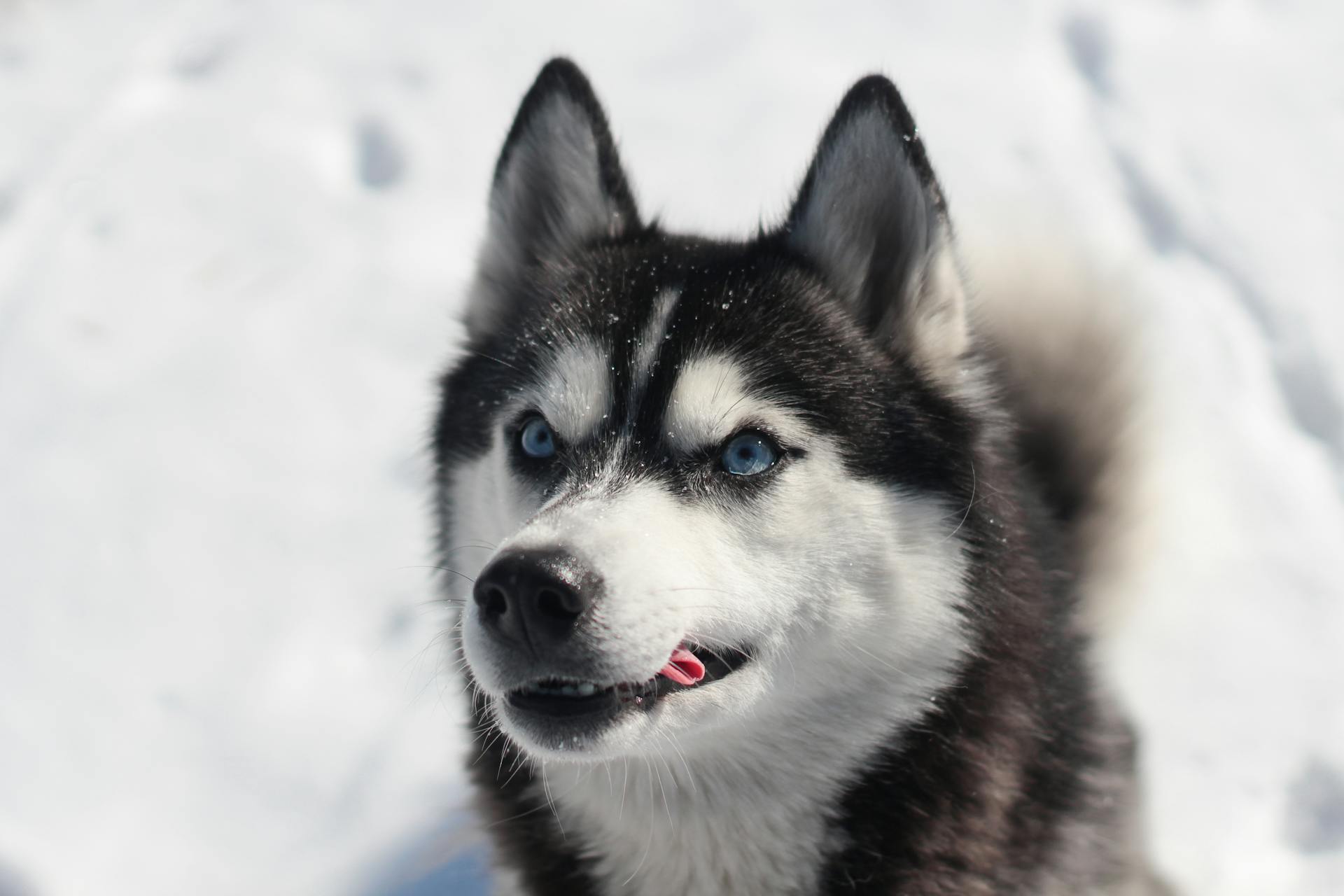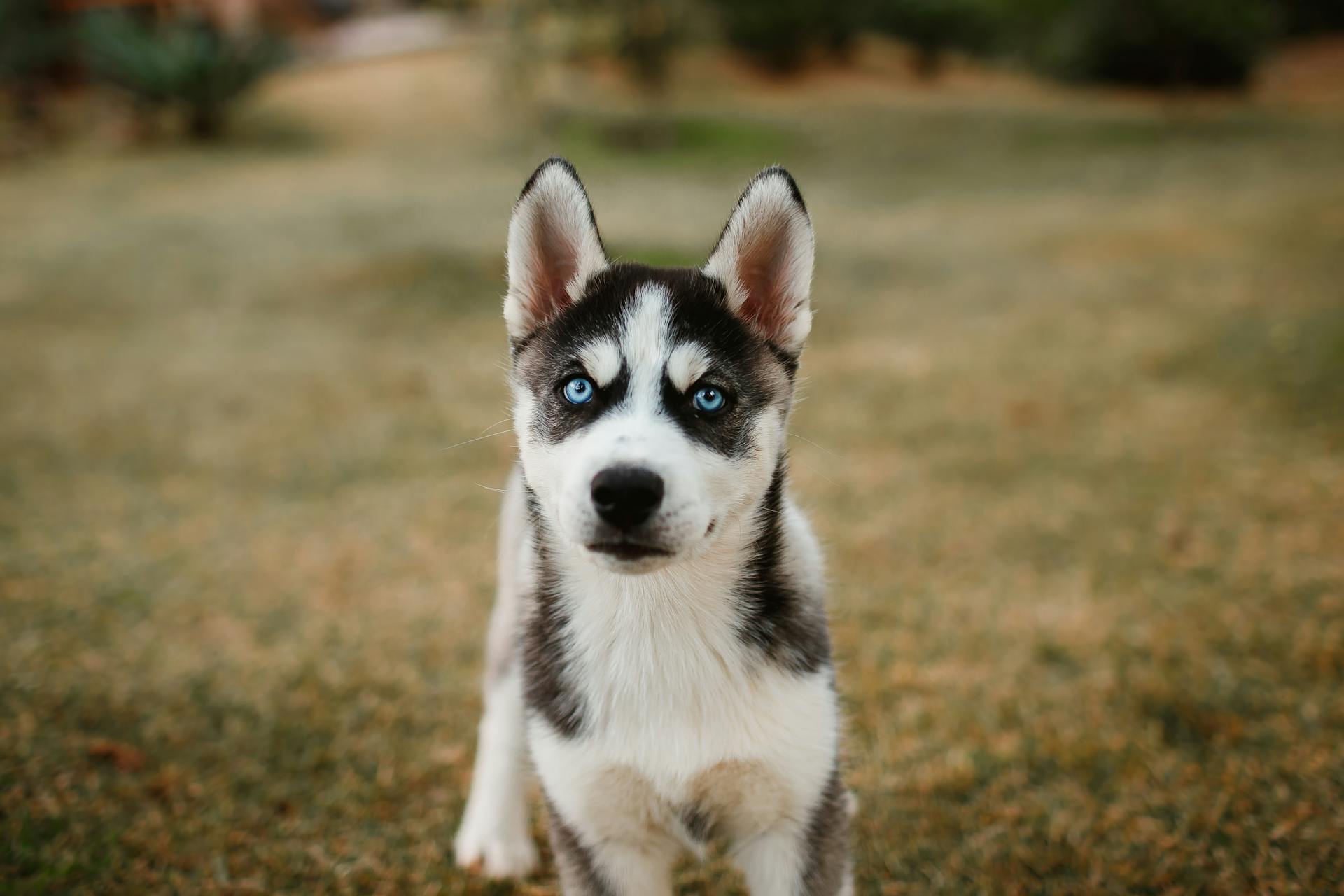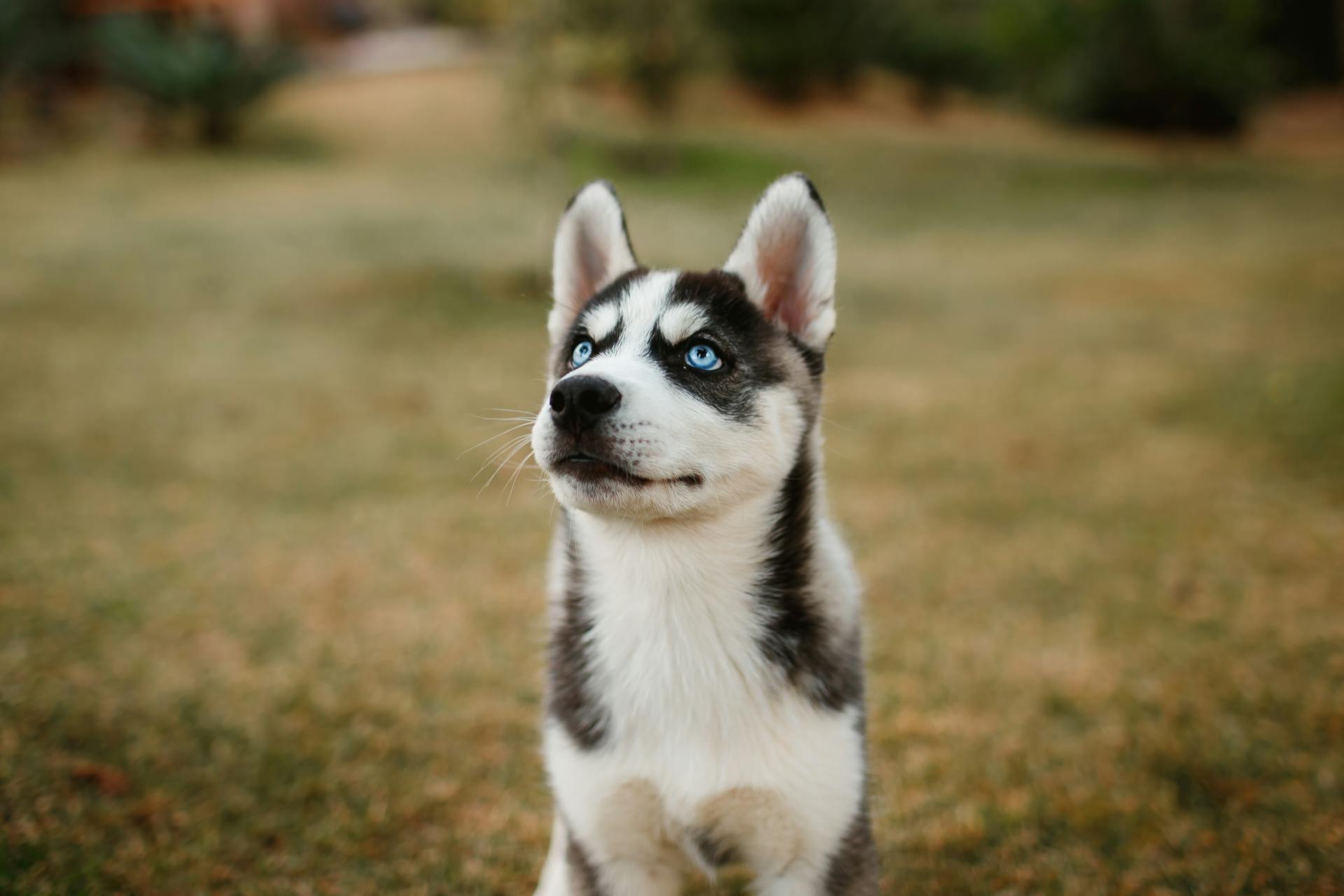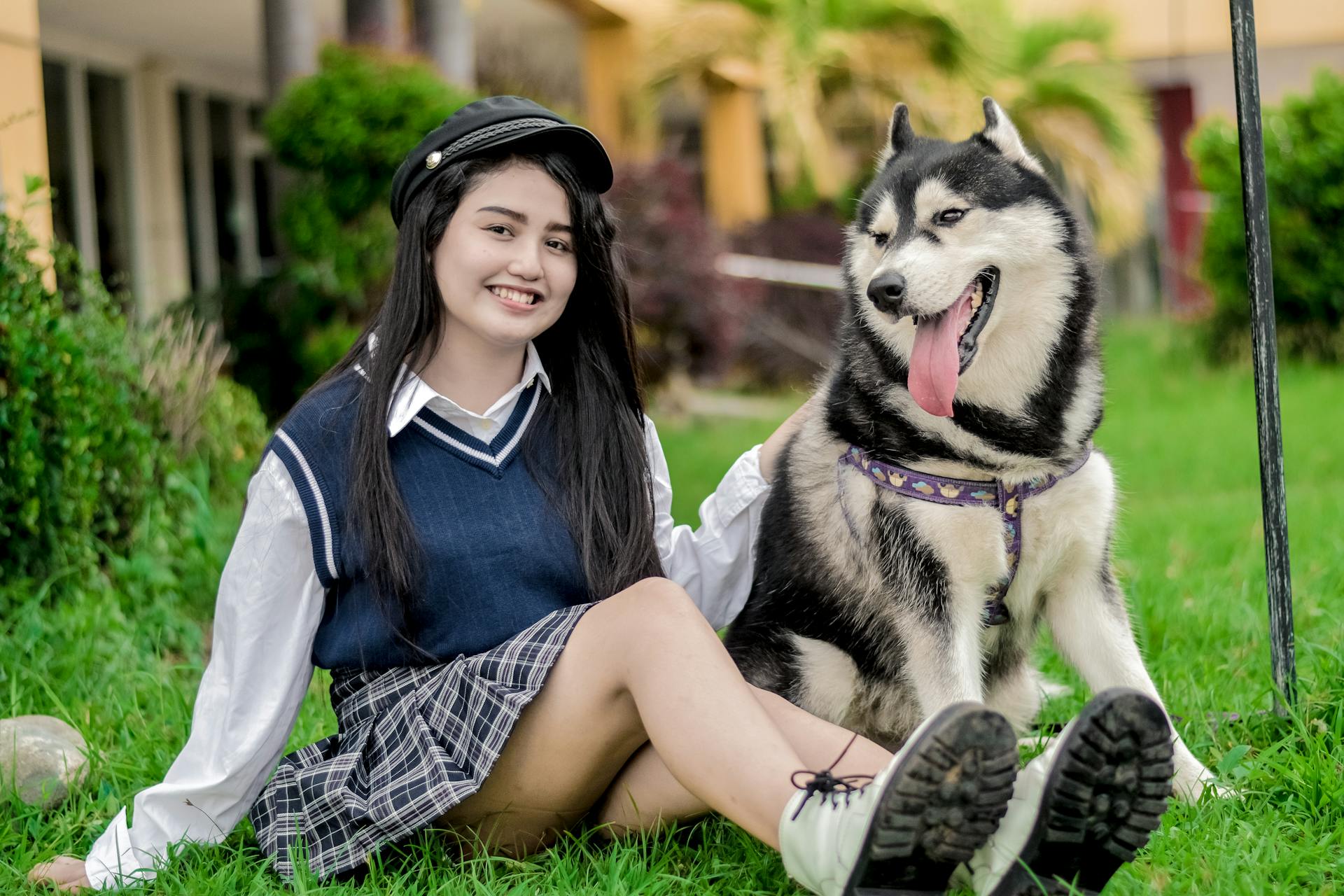
Huskies are a breed of dog that originated in Siberia, where they were bred to be working dogs, pulling sleds and hunting.
They have a thick double coat that protects them from the extreme cold of their native climate.
Huskies are known for their striking appearance, with a wolf-like appearance and piercing blue eyes.
Their thick coats require regular grooming to prevent matting and tangling.
Physical Characteristics
Siberian Huskies typically have a thick double coat that protects them against harsh winters. They can also survive in hotter climates by shedding their undercoat to cool down.
Their eyes are usually pale blue, but can also be brown, green, blue, yellow, or heterochromic. This is a distinctive characteristic of the breed.
Huskies are a medium-sized breed, with males growing to be 21-23½ inches tall and females growing to be 20-22 inches tall. They weigh between 45-60 pounds for males and 35-50 pounds for females.
Their dense coats allow them to withstand extreme cold, and they can even change their metabolisms to go long distances without fatigue. This is a remarkable adaptation that helps them thrive in their natural environment.
General Appearance
The Siberian Husky is a medium-sized breed with a well-balanced working dog body.
Their moderately compact, well-furred body, erect ears, and brush tail are all indicative of their Northern heritage.
A Siberian Husky in proper condition has firm, well-developed muscles without excess weight.
Their proportions and form reflect a balance of power, speed, and endurance, making them well-suited for pulling a light load at a moderate speed over great distances.
Males are masculine but never coarse, and females are feminine but not weak.
Their thick coats protect them against harsh Arctic winters, but also reflect heat in the summer, allowing them to withstand temperatures as low as -50 to -60 °C (-58 to -76 °F).
Height and Weight
When measuring your dog's height, it's essential to know that it's measured at the withers.
The height range for males is 21 inches up to 23½ inches, and for females, it's 20 inches up to 22 inches.
Height is directly related to weight, and the weight range for males is 45 to 60 pounds, while for females, it's 35 to 50 pounds.
Gait
A dog's gait is a key aspect of its physical characteristics. It's smooth and effortless, with a good reach in the forequarters and drive in the hindquarters.
As you watch a dog move, notice how its topline remains firm and level. This is especially evident when it's trotting at a moderate pace.
At faster speeds, the dog single tracks, meaning its hind legs move in the path of its corresponding forelegs. This is a testament to its agility and coordination.
A good gait is essential for a dog's overall movement and balance. Avoid dogs with short, prancing, or choppy gaits, as these can be signs of underlying issues.
Nose
The nose of a Siberian Husky is quite unique. It's preferred to be neither pointed nor square in show-quality dogs.
The color of the nose varies depending on the dog's coat color. In gray dogs, the nose is black, while in black dogs, it's tan.
Liver-colored dogs have liver-colored noses, and white dogs may have light tan noses.
See what others are reading: Bull Terrier Nose
Breeds and Types
Husky breeds are divided into two main categories: Siberian Huskies and Alaskan Huskies.
Siberian Huskies are known for their wolf-like appearance and are often used for sled pulling. They have a thick double coat that sheds heavily.
Alaskan Huskies are a more general term for a group of dogs that are bred for sled pulling and are often used for racing.
Coat Types and Colors
Siberian Huskies have a unique coat that's thicker than most other breeds, comprising two layers: a dense undercoat and a longer topcoat of short, straight guard hairs.
Their coat protects them effectively against harsh Arctic winters, but it also reflects heat in the summer. It can withstand temperatures as low as −50 to −60 °C (−58 to −76 °F).
Their thick coats require weekly grooming to prevent matting and tangling. You'll want to get your Siberian Husky used to this routine from an early age.
The most common coats are black and white, followed by copper-red and white, grey and white, pure white, and the rare "agouti" coat.
Breeds

The world of dog breeds is a vast and fascinating one, and within it, there's a specific category that's worth exploring: breeds that contain the word "husky" in their name. Let's take a closer look at some of these breeds.
The Alaskan husky is a great example of a breed that's been specifically bred for its performance as a sled dog. They typically weigh between 40 and 75 pounds.
One of the unique things about the Alaskan husky is that it's a mongrel, meaning it's a mix of different breeds. In fact, it's been crossbred with English Pointers, German Shepherd Dogs, Salukis, and other breeds to improve its performance.
The Alaskan husky is often used in dog sled racing, where its speed and endurance are put to the test. They're a popular choice for this type of racing due to their athleticism and agility.
Here's a brief rundown of some other breeds that contain the word "husky" in their name:
Note: The weights listed above are approximate and may vary depending on the individual dog.
Labrador
The Labrador region has a rich history with dogs, with the Labrador Husky originating there.
The Labrador Husky likely arrived in Labrador with the Inuit around 1300 AD.
Despite its name, the Labrador Husky is not related to the Labrador Retriever.
The Labrador Husky is actually most closely related to the Canadian Eskimo Dog.
Sakhalin
Sakhalin is home to a critically endangered landrace called the Sakhalin Husky. They're also known as Karafuto Ken, Sakhalin Laika, or Gilyak Laika.
The Sakhalin Husky was bred primarily as a sled dog. They're also used for hunting bear and fishing.
There are approximately 20 Sakhalin Huskies remaining on Sakhalin Island.
Suggestion: Yakutian Laika
Temperament and Behavior
Siberian Huskies are known for their friendly and gentle nature, but they also have a strong prey drive and can be mischievous. They love exploring and will often try to escape from insecure areas.
Their high energy levels mean they need regular exercise and mental stimulation to prevent destructive behavior. A 15-minute daily obedience training class can be beneficial in keeping them engaged and well-behaved.
As a breed, Huskies crave company and love spending time with their owners. They have a great sense of humor and are playful, but they also display an independent side and can be strong-willed.
Here are some key temperament traits to consider:
- Huskies are generally good with children, but they do require proper care and attention.
- They are not suitable for owners who will leave them alone for long periods of time, as they can suffer from separation anxiety.
- Huskies are highly social and love making friends with strangers, but they do have a strong prey drive and may not get along with other pets.
Their intelligence and tractability make them agreeable companions and willing workers, but they can be stubborn at times. With consistent training and positive reinforcement, Huskies can learn to behave well and be loyal companions.
Care and Maintenance
To keep your Husky's coat looking its best, regular brushing is a must. Brushing 2 or 3 times a week is recommended to remove any shed or loose hair.
A Husky's coat requires extra care during moulting season, when they tend to shed a lot. This is known as 'blowing coat' and can be managed with more frequent brushing.
In addition to coat care, it's essential to keep your Husky cool and happy during the hotter summer months. This means taking extra precautions to prevent overheating.
Here are some specific grooming tasks to remember:
- Brush your Husky 2-3 times a week to prevent matting and tangling.
- Check your Husky's ears regularly for signs of infection caused by excess wax.
- Brush your Husky's teeth regularly with a vet-approved toothpaste to maintain good dental hygiene.
Nutrition
Huskies are active dogs, but they don't need as much food as you might think. An adult Husky typically needs around 1,000 calories each day, split over two meals.
Be careful with the ingredients in your Husky's dog food. Some cereals like wheat can be hard for them to digest.
Regular exercise is essential for Huskies. They have a naturally slow metabolism, so burning off energy helps stimulate their appetite.
Their thick fur can make them prone to overheating, especially during summer months. Make sure your Husky has plenty of fresh water to avoid dehydration.
Grooming
Grooming is an essential part of caring for your Husky. Regular brushing is a must to remove shed or loose hair.
Huskies have a dense, double coat that needs to be brushed 2 or 3 times a week to keep it in good condition. This will help prevent matting and tangling, especially during the spring and autumn when they tend to shed a lot.
You might enjoy: Bull Terrier Shed
During moulting season, known as 'blowing coat', Huskies will shed even more, so be prepared to brush them more frequently to keep their coats in good condition.
In addition to brushing, it's also important to check their ears regularly for any signs of infection caused by excess wax. Regular dental hygiene is also a must, including brushing with a vet-approved toothpaste.
Here's a quick rundown of what you need to do:
- Brush your Husky 2-3 times a week
- Increase brushing frequency during moulting season
- Check their ears regularly for signs of infection
- Brush their teeth regularly with a vet-approved toothpaste
Things to Consider Before Buying or Rehoming a Dog
Thinking about getting a Husky? Before you make the leap, it's essential to consider their needs and temperament.
Huskies require at least 2 hours of exercise each day, so if you're not an active person, they might not be the best fit.
Their high prey drive means they need to be kept on a lead during walks, and any outdoor space must be safe and secure to prevent escape attempts.
A strong independent streak and tendency for mischief require early and consistent training, finding the right balance between firm and fair.
Assessing the temperament of the parents and their breeding lines can help you understand the kind of dog you're getting, and whether they'll be a good match for your lifestyle.
Here are some key things to consider before bringing a Husky home:
- Active lifestyle and plenty of time required
- High prey drive and need for secure outdoor space
- Early and consistent training necessary
- Assess temperament and breeding lines of parents
Frequently Asked Questions
Are huskies hard to train?
Yes, Siberian Huskies can be challenging to train due to their strong will and independent nature. With patience and consistent training, however, they can learn to obey commands and behave well.
What not to do to a Husky?
Don't keep Siberian Huskies in tight spaces, as they are skilled escape artists. Apartment living may not be suitable for this breed
Featured Images: pexels.com


